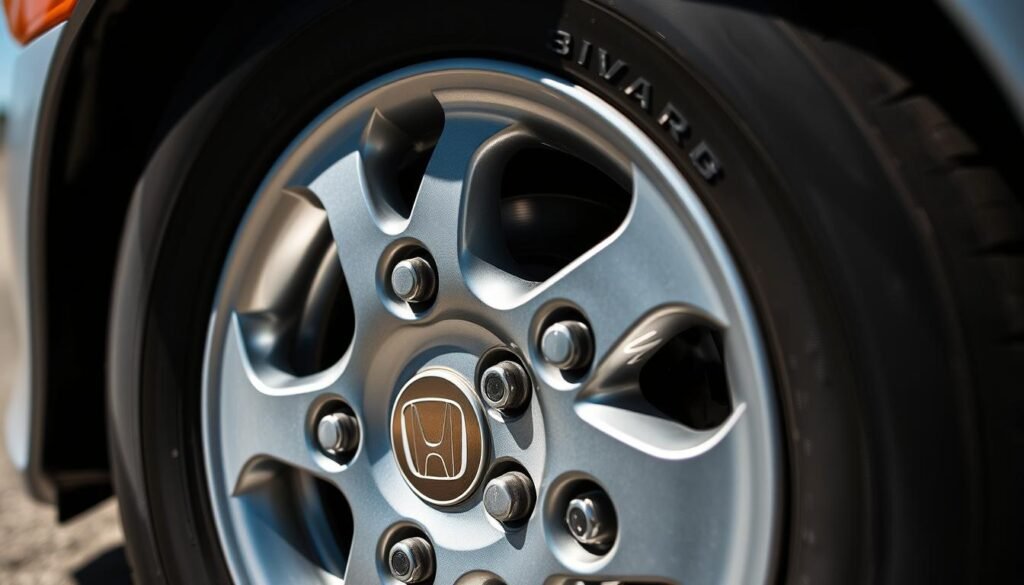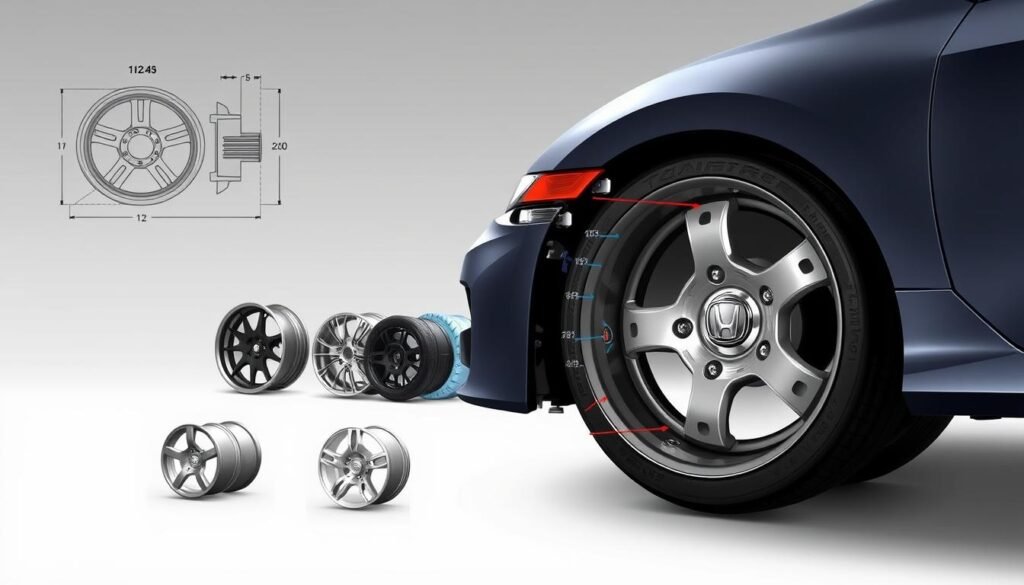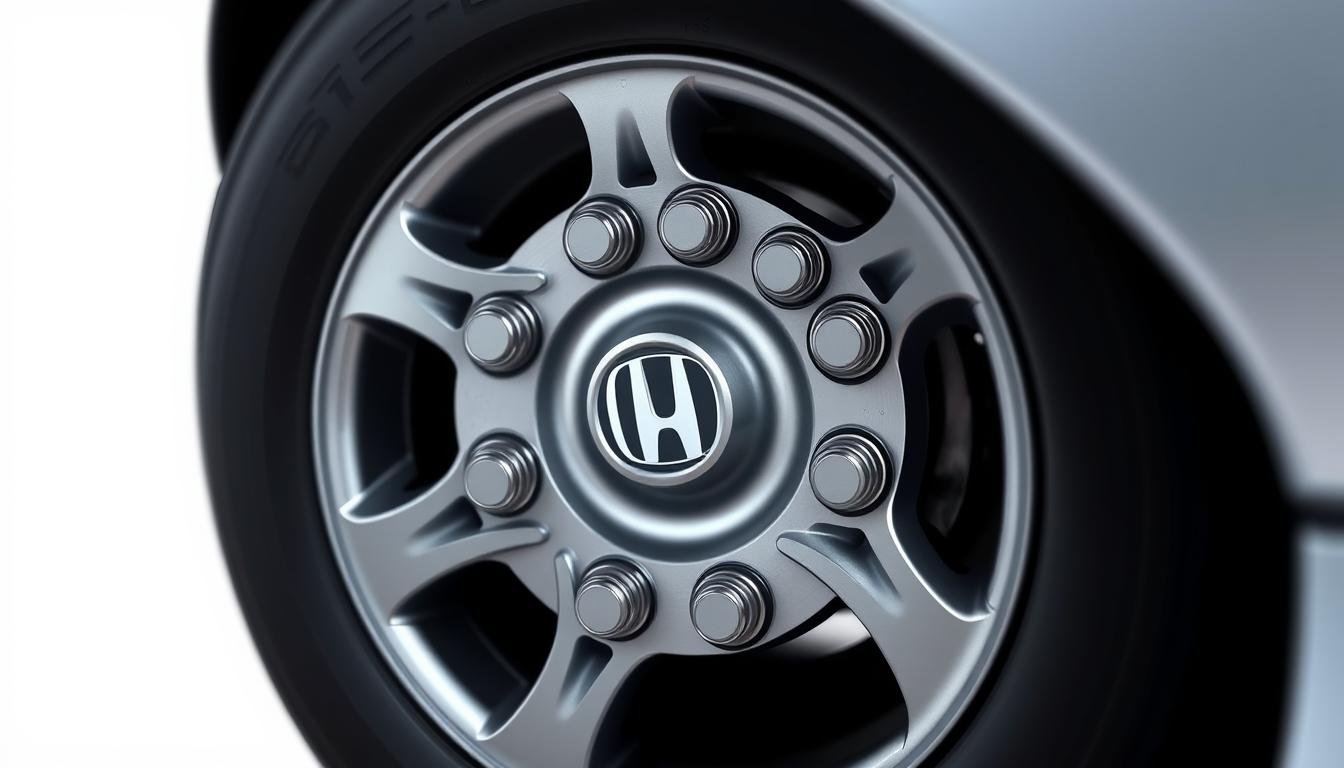Honda Civic Lug Pattern Guide | Quick Specs
What’s the lug pattern for a Honda Civic? It changes with different models, usually from 4x100mm to 5×114.3mm.
Knowing your Civic’s bolt pattern is key to picking the right wheels that fit well and safely. This guide gives you the specs and insights on various lug patterns for different Civic models.
It makes choosing wheels simpler and more accurate. This guide teaches you how to spot your Honda Civic wheel pattern.
You’ll also learn about what affects wheel compatibility, and how to keep your lug patterns in top shape.
We’ll talk about how to measure properly and the importance of correct lug nut specs.
Whether you’re customizing for looks or swapping old wheels, the right info is crucial. It ensures your Civic performs its best.
What is The Importance of Bolt Patterns?
Bolt patterns are crucial for your Honda Civic. They ensure your wheels fit perfectly, linking safety to performance. Each wheel is attached by bolts.
The right pattern helps them fit correctly, boosting stability while driving. If the bolt pattern doesn’t match, you might face issues like wheel shake, worse handling, or wheels coming off.
These problems not only affect how your car drives but also can be very risky. Knowing bolt patterns helps you choose wisely, especially for aftermarket wheels.
The lug bolt pattern of the Honda Civic greatly affects how long your wheels and tires last.
A correct fit not only improves your car’s appearance but its safety and reliability too. Picking the right bolt pattern helps your tires last longer and makes driving better.
What is The Bolt Pattern For A Honda Civic?
The bolt pattern for a Honda Civic changes with the year it was made. For older models from 1973 to 2000, they mostly have a honda civic lug pattern of 4x100mm.
This means there are four bolts making a circle, and the circle is 100mm across. However, most Honda Civics made after 2000 have a 5×114.3mm pattern.
This design uses five bolts and the distance between them is 114.3mm. Knowing the honda civic bolt pattern definition helps you pick the right wheels.
This ensures they fit perfectly and keep you safe while driving. Choosing the right bolt pattern is key to your car’s performance and safety.
It’s important to know your Honda Civic’s year and model to get the exact bolt pattern. Before you buy new wheels or replacements, always check this detail.

Honda Civic Lug Pattern: Generational Changes
The Honda Civic has changed a lot, especially with its lug patterns. These changes show the car’s design and technology growth.
Knowing the differences helps pick the right wheels, making your car safer and work better.
4x100mm Pattern in Older Models
Older Civics from 1973 to 2000 used a 4x100mm bolt pattern. This means four bolts are set in a circle that measures 100mm across.
This pattern matched the lighter build of early Civics, setting a standard for wheel fitting in those years.
5×114.3mm Pattern in Newer Models
Since 2001, the Honda Civic has a 5×114.3mm bolt pattern. This change means five bolts in a circle, 114.3mm apart.
It allows for bigger wheels which increase stability and strength. This update shows Honda’s focus on better performance and adaptability in its cars.

Factors Impacting Compatibility with Aftermarket Wheels
Choosing aftermarket wheels for your Honda Civic involves knowing key fitment factors. This ensures both good performance and safety.
Wheels need to meet more than just bolt pattern specifications. Wheel offset, hub bore size, and the right lug nuts are critical too.
Learning Wheel Offset and Hub Bore
Wheel offset affects how wheels fit with the car’s body and suspension. A positive offset moves the wheel towards the suspension.
A negative offset moves it away. Getting this wrong can cause alignment problems, uneven tire wear, and poor handling.
The hub bore size needs to match your Civic’s specs for a tight fit. If it’s too big, the wheel might not attach securely. Both offset and hub bore are key for fitting aftermarket wheels correctly.
Choosing The Correct Lug Nuts
Finding the right lug nuts is vital for securing the wheels. Different wheels might need specific lug nuts. Using the wrong ones can cause vibrations and safety issues, especially at high speeds.
It’s important to check the specs when picking lug nuts. This choice directly affects your Honda Civic’s wheel assembly’s success.

| Factor | Description | Impact on Compatibility |
|---|---|---|
| Wheel Offset | Distance between the wheel center and mounting surface | Affects alignment and handling |
| Hub Bore | Inner diameter of the wheel that fits over the hub | Ensures secure mounting and prevents vibrations |
| Lug Nuts | Fasteners that hold the wheel onto the hub | Essential for safe and effective wheel attachment |
Honda Civic Bolt Patterns by Generation
The Honda Civic has changed a lot over the years, each generation having its own bolt pattern.
It’s important to know these details to choose the right wheels. Let’s look at the bolt patterns for old and new Civics and see how they differ.
Early Civic Models (1973-2000)
From 1973 to 2000, Honda Civics had a 4x100mm bolt pattern. This size matched the design and needs of the time. These smaller wheels fit the sleek design of the cars from this period.
Modern Civic Models (2001-Present)
Starting in 2001, the Honda Civic began using a 5×114.3mm bolt pattern. This was a big change, making room for bigger wheels.
Bigger wheels help the car perform better and look nicer. This new size also lets drivers pick from more wheel options, making customization easier.

Knowing the bolt pattern differences helps Civic owners make smarter choices about wheels. This info helps make sure the wheels fit and meet the car’s needs.
Special Models: Civic Type R and Ridgeline Bolt Patterns
The civic type r bolt pattern measures 5×114.3mm, making it match other modern Honda cars. This design lets owners easily find new wheels that fit.
The Civic Type R stands out for its sporty look and performance that excites car fans. The Honda Ridgeline also uses the 5×114.3mm bolt pattern.
This makes it easy for Honda owners to swap wheels between their vehicles. Its wheels are made for off-road adventures and carrying heavy loads, perfect for people who need a truck that does it all.
Both the Civic Type R and Ridgeline show Honda’s focus on new ideas and strong performance.
Knowing the honda ridgeline lug specifications helps with keeping the vehicles in good shape and upgrading them.
| Model | Bolt Pattern | Application |
|---|---|---|
| Civic Type R | 5×114.3mm | Performance-oriented driving |
| Honda Ridgeline | 5×114.3mm | Hauling and off-road capabilities |
Visual Guide: Bolt Pattern Tables For Honda Models
Understanding the bolt patterns for Honda models makes picking wheels easier. Below is a bolt pattern table for Honda cars. It’s a handy guide for car fans and Honda owners.
| Model | Years | Bolt Pattern |
|---|---|---|
| Civic (Early) | 1973 – 2000 | 4x100mm |
| Civic (Modern) | 2001 – Present | 5×114.3mm |
| Civic Type R | 2017 – Present | 5×114.3mm |
| Accord (Early) | Up to 1997 | 4×114.3mm |
| Accord (Modern) | 1998 – Present | 5×114.3mm |
How To Measure The Honda Civic Lug Pattern Accurately?
Measuring your Honda Civic’s lug pattern correctly is needed when buying new wheels. You will need a few tools and a simple method.
Let’s learn how to measure your bolt pattern so your new wheels will fit just right.
Tools Required for Accurate Measurement
- Measuring tape or a ruler
- Calipers for precision
- Bolt pattern gauge for complex patterns
Step-by-Step Measurement Process
- Start by cleaning the wheel hub area to remove any debris that could interfere with accurate measuring honda civic lug pattern.
- If measuring a 4-lug wheel, measure across the center of two opposing lug holes.
- For 5-lug wheels, measure from the center of one lug hole to the back of the lug two positions over to accurately assess how to measure bolt pattern.
| Wheel Type | Measurement Method |
|---|---|
| 4-Lug | Measure across opposing lug holes |
| 5-Lug | Center of one lug to the back of two positions over |
Maintenance Tips For Honda Civic Lug Patterns
Keeping your Honda Civic’s lug pattern in top shape is key for great performance and safety.
By regularly checking and cleaning, you can make your wheels and tires last longer. This also keeps the lug pattern working well.
Regular Wheel Checks
Each month, make sure the lug nuts on your wheels are tight. This stops the wheels from getting out of line and wearing out too fast. A smooth ride and reliable driving come from doing this check.
Cleaning and Preventing Corrosion
Clean your wheels with soft soap and water to remove brake dust and dirt. After cleaning, put on a protective layer to keep rust at bay, especially in places with bad weather.
Cleaning often will help your lug pattern and wheels stay in good condition for longer.
| Maintenance Task | Frequency | Benefits |
|---|---|---|
| Inspect lug nut tightness | Monthly | Prevents wheel misalignment |
| Clean wheels | Bi-weekly | Removes dirt and brake dust |
| Apply protective coating | Seasonally | Prevents rust and corrosion |
Honda Civic Lug Nut Details: Size and Torque Requirements
Knowing the right specs for your Honda Civic’s lug nuts is key for safe wheel installation. With the right info, you can keep your vehicle’s wheels in top shape and boost its performance.
Lug Nut Size Specifications
The standard size for a Honda Civic lug nut is usually 12×1.5mm. This fits most Civics, but always double-check for your model.
Using the right size ensures the wheel stays tight, reducing the risk of it coming loose or misaligning.
Lug Nut Torque Settings and Sequence
The lug nuts should be tightened to 80-85 foot-pounds. This secures the wheels well without causing damage.
Always use a star pattern when tightening. This method helps spread the pressure evenly and seats the wheel right against the hub.
Conclusion
Choosing the right wheels for your Honda Civic is crucial. The correct lug pattern is essential for safety and car performance.
Knowing this helps prevent expensive mistakes when changing wheels. It also makes sure your car drives well.
Different Honda Civics have different bolt patterns. It’s important to know this to make smart choices.
Good care of your Civic increases its life and reliability. By using this guide’s advice, you protect your driving experience and your car’s value.
FAQs
Q: What is the lug pattern for a 2020 Honda Civic?
A: The lug pattern for a 2020 Honda Civic is 5×114.3mm.
Q: How do I know if the lug nut size is correct for my Honda Civic?
A: Most Honda Civics use a 12×1.5mm lug nut size. Check your model’s specs to be sure.
Q: What is the torque specification for Honda Civic lug nuts?
A: Honda Civic lug nuts should be tightened to 80-85 foot-pounds of torque.
Q: How can I measure the lug pattern of my Honda Civic?
A: To measure, use a tape or calipers. Measure the distance across opposite lug holes: 100mm for 4-lug and 114.3mm for 5-lug.
Q: What are the symptoms of mismatched bolt patterns on my Honda Civic?
A: If bolt patterns don’t match, you might notice wheel shakes or vibrations. This is dangerous and can lead to wheel separation while driving.
Q: Can I use wheels from an older Honda Civic on newer models?
A: No, older Honda Civics’ 4x100mm wheels won’t fit newer models with a 5×114.3mm pattern.
Q: How often should I check the tightness of my lug nuts?
A: Check your lug nuts’ tightness every month. This keeps your wheels aligned and your ride smooth.
Q: What should I do if my lug nut key is lost?
A: Lost your lug nut key? Contact a dealer for a new one, or use a special tool to remove the nuts.







